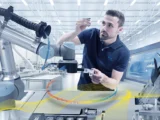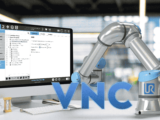Five Reasons Why HMI Designer is Your Best Choice for Universal Robots
In the evolving landscape of industrial automation, creating intuitive and effective Human-Machine Interfaces (HMIs) is crucial for seamless interaction with robotic systems. Robpod Studio HMI Designer emerges as a standout tool for designing custom HMI panels tailored specifically for Universal Robots. This article explores five compelling reasons to use Robpod Studio.
1. Drag-and-Drop Design: A WYSIWYG Approach
One of the most significant advantages of Robpod Studio is its drag-and-drop design functionality, which follows a What You See Is What You Get (WYSIWYG) approach. This feature simplifies the design process, making it accessible even to those with limited programming experience.
With Robpod Studio, users can build complex HMI panels by simply dragging components from a library and dropping them onto the design canvas. This visual approach allows for immediate feedback on how the final interface will look and function, streamlining the design process and reducing the need for extensive coding.
The WYSIWYG design environment facilitates rapid prototyping and iteration. Users can experiment with different layouts, widgets, and styles in real time, ensuring that the final product meets their specific needs without the hassle of traditional coding. This feature enhances efficiency and accelerates the development of user-friendly HMI panels.
2. Live Data Display and Monitoring
Real-time data display and monitoring are critical for effective operation and control of robotic systems. Robpod Studio excels in this area by enabling users to incorporate live data into their HMI panels. This functionality allows operators to view real-time metrics, statuses, and feedback directly from their Universal Robots.
The ability to display live data provides a dynamic interface that reflects the current state of the production process. Users can monitor key performance indicators, track progress, and respond to changes as they happen. This real-time visibility is essential for maintaining operational efficiency, diagnosing issues promptly, and making informed decisions based on up-to-date information.
3. Polyscope and URScript: Linking Variables and Functions
Integration with Polyscope and URScript, Universal Robots’ proprietary programming languages, is another standout feature of Robpod Studio. This integration allows for seamless linking of variables and functions between the HMI panels and the robotic systems.
Robpod Studio can easily connect HMI elements with variables and functions defined inside Polyscope or UrScripts. This capability enables users to create interactive interfaces that can control robotic actions, adjust parameters, and display real-time data based on the robot’s state. By linking HMI elements directly with Polyscope or URScript, users can develop more sophisticated and responsive interfaces that enhance the overall functionality of their robotic systems.
4. Extensive HMI Customization
Customization is at the core of Robpod Studio’s functionality. The software provides extensive options for tailoring HMI panels to meet specific needs and preferences. Users can customize various aspects of their HMIs, including layout, visual design, and interactive elements.
Robpod Studio allows for the incorporation of custom graphics, logos, and branding elements, ensuring that the HMI panels align with the user’s operational requirements and corporate identity. Additionally, users can design custom widgets, buttons, and controls to create an interface that is intuitive and easy to navigate.
The flexibility in customization ensures that the HMI panels not only serve their functional purpose but also enhance the user experience. Whether you need a highly specialized control panel or a simple monitoring interface, Robpod Studio’s customization features provide the tools needed to achieve your design goals.




5. Direct Integration with Universal Robots: HMI on the Teach Pendant
A unique and powerful feature of Robpod Studio is its direct integration with Universal Robots, allowing custom HMI panels to be displayed directly on the robot’s teach pendant. This integration eliminates the need for separate devices or screens, streamlining the user interface and providing immediate access to the HMI within the robot’s operating environment.
Displaying the HMI directly on the teach pendant offers several advantages. It consolidates control and monitoring functions into a single interface, reducing the complexity of managing multiple devices. Operators can interact with the HMI panel without leaving the robot’s teach pendant, enhancing convenience and efficiency.
This direct integration also simplifies the deployment of custom HMIs, as there is no need for additional hardware or complex setup procedures. Users can create and deploy their custom interfaces quickly and easily, ensuring a seamless integration with their Universal Robots.
Conclusion
Robpod Studio HMI Designer offers a range of powerful features that make it an ideal choice for creating custom HMI panels for Universal Robots. Its drag-and-drop design functionality simplifies the creation process, while live data display and monitoring provide real-time insights into robotic operations. The integration with Polyscope/URScript allows for dynamic and interactive interfaces, and extensive customization options ensure that the HMIs meet specific user needs. Finally, the direct integration with Universal Robots, allowing HMIs to be displayed on the teach pendant, streamlines control and monitoring.
By leveraging these features, users can develop intuitive, responsive, and highly functional HMI panels that enhance their interaction with Universal Robots. Robpod Studio not only simplifies the design and implementation process but also empowers users to create interfaces that optimize their robotic systems and improve overall operational efficiency.
Get Started Now!
👨💻 Read the Docs




